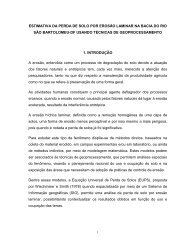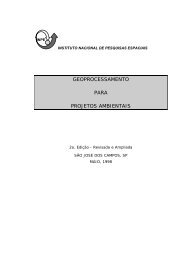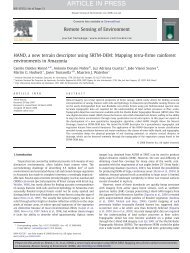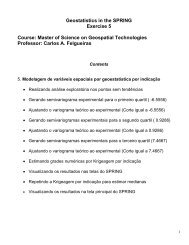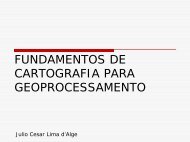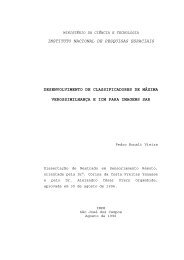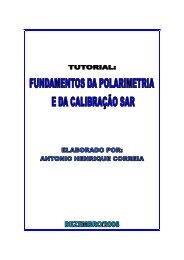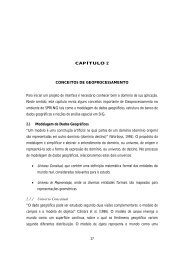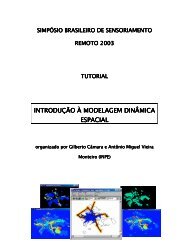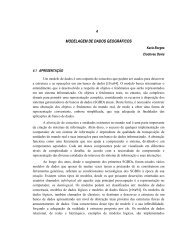The Amazon Deforestation Monitoring System: A large ... - DPI - Inpe
The Amazon Deforestation Monitoring System: A large ... - DPI - Inpe
The Amazon Deforestation Monitoring System: A large ... - DPI - Inpe
Create successful ePaper yourself
Turn your PDF publications into a flip-book with our unique Google optimized e-Paper software.
Foundation for Space Science, Technology and Applications<br />
<strong>The</strong> <strong>Amazon</strong> <strong>Deforestation</strong> <strong>Monitoring</strong> <strong>System</strong>:<br />
A <strong>large</strong> environmental database developed<br />
on TerraLib and PostgreSQL<br />
Vanildes Ribeiro - <strong>System</strong> Analyst – FUNCATE - vanildes@funcate.org.br<br />
Gilberto Queiroz – Researcher - INPE – gribeiro@dpi.inpe.br
� Non profit private foundation<br />
� Engaged on projects of<br />
spatial applied research and<br />
spatial technology transfer.<br />
� Founded in 1982 (25 years)<br />
� Technical agreements with<br />
Brazilian Research Partners<br />
Foundation for Space Science, Technology and Applications<br />
National Institute for Space Research<br />
Aerospatial Technical Center<br />
Brazilian Air Force<br />
Brazilian Technology Institute Science<br />
Mineral Technology Center
<strong>The</strong> <strong>Amazon</strong> rainforest monitoring system of the PRODES project.
To produce deforestation maps of the<br />
Brazilian <strong>Amazon</strong>.<br />
Goals<br />
To calculate the annual deforestation rate
Background<br />
Brazil uses remote sensing satellite<br />
data to monitor deforestation in the<br />
Brazilian <strong>Amazon</strong> biome, which<br />
covers an area of 4,7 million square<br />
kilometers.<br />
Every year a deforestation map and a<br />
yearly deforestation rate, are produced<br />
and disseminated through the<br />
Internet.<br />
<strong>The</strong> monitoring requires that a<br />
complete coverage of satellite images,<br />
with 20 to 30 meters resolution, to be<br />
acquired, automatically processed and<br />
analyzed by technicians.
<strong>Amazon</strong> deforestation in 2003<br />
mapped by PRODES<br />
Background<br />
Increasing <strong>Deforestation</strong> in <strong>Amazon</strong>
Background<br />
• PRODES was initiated at the end of the 80's using analogical interpretation<br />
process.<br />
• In the following years deforestation mapping evolved to a fully digital<br />
procedure using SPRING. <strong>Deforestation</strong> mapping demanded 229<br />
independent databases, each one covering one LANDSAT 5 satellite image,<br />
creating an environment of complex management.<br />
• <strong>The</strong> complexity would increase with the use of images from other<br />
satellites (CBERS, LANDSAT, DMC), which are needed to guarantee data<br />
availability under a satellite operational breakdown.<br />
• Terra<strong>Amazon</strong> was developed to simplify deforestation mapping in this<br />
scenario with the advantage of delivering faster results.
TerraLib implements<br />
methods for image and<br />
vector data processing and<br />
analysis.<br />
TerraPHP extends PHP to<br />
access TerraLib for web<br />
applications.<br />
SPRING implements a<br />
variety algorithms for<br />
images and vector data<br />
processing.<br />
Technologies<br />
Multiplatform LINUX or Windows machines.<br />
Developed using C++ and the graphical widget toolkit QT.<br />
Database server running on PostgreSQL version 8.2, on a<br />
LINUX Server.<br />
Developed based on TerraLib open source technology<br />
(www.terralib.org).<br />
Web site running on TerraLib PHP extension and TerraLib<br />
OGC WMS server.<br />
Repository of image processing algorithms SPRING<br />
www.dpi.inpe.br/spring
Methodology<br />
Terra<strong>Amazon</strong> manages all operations using a unique corporate<br />
database in a distributed and concurrent environment.<br />
Cells were created by partitioning the project extents using a 0.25<br />
degrees grid.<br />
Each interpreter can lock one or more cells to process using a<br />
long transactions schema.<br />
Image processing tools are used to automatically extract<br />
deforestation polygons and include: TIFF format image import,<br />
georeferencing using control points, enhancement and color<br />
composition, mixture model, segmentation, and classification.
Reference Image<br />
Shade Image or<br />
Agregado<br />
( accumulated<br />
deforestation + no forest<br />
+ hydrography)<br />
Georeferencing<br />
Auditing<br />
Auditing<br />
OK?<br />
Mixture Model<br />
Segmentation<br />
Import<br />
Image<br />
Image IN<br />
Soil Image<br />
Control points<br />
Corrected Image<br />
Approved<br />
Image<br />
Several<br />
clouds?<br />
Clouds Classification<br />
Raster2Vector<br />
Vectors<br />
Classified<br />
Image<br />
Methodology<br />
Interpretation and<br />
Edition<br />
Auditing<br />
Auditing<br />
ok?<br />
Dissemination
Import Image<br />
Georeferencing<br />
Mixture Model<br />
Segmentation<br />
Classification<br />
Interpretation<br />
and Edition<br />
Auditing<br />
Dissemination<br />
RAW<br />
SPR GRID<br />
ESRI ASCII GRID<br />
Methodology<br />
GeoTIFF<br />
JPEG
Import Image<br />
Georeferencing<br />
Mixture Model<br />
Segmentation<br />
Classification<br />
Interpretation<br />
and Edition<br />
Auditing<br />
Dissemination<br />
• Interactive interfaces<br />
• Equalization functions<br />
Methodology<br />
Interpolators:<br />
Near Neighborhood<br />
Bilinear<br />
Bicubic
Import Image<br />
Georeferencing<br />
Mixture Model Model<br />
Segmentation<br />
Classification<br />
Interpretation<br />
and Edition<br />
Auditing<br />
Dissemination<br />
Vegetation Image<br />
Original Image<br />
Shade Image<br />
Methodology<br />
Soil Image
Import Image<br />
Georeferencing<br />
Mixture Model<br />
Segmentation<br />
Classification<br />
Interpretation<br />
and Edition<br />
Auditing<br />
Dissemination<br />
Methodology<br />
Input Soil Image Output Vectors
Import Image<br />
Georeferencing<br />
Mixture Model<br />
Segmentation<br />
Classification<br />
Interpretation<br />
and Edition<br />
Auditing<br />
Dissemination<br />
Input Image and<br />
Output Clouds<br />
K-means classification<br />
Methodology<br />
Input Image
Import Image<br />
Georeferencing<br />
Mixture Model<br />
Segmentation<br />
Classification<br />
Interpretation<br />
and Edition<br />
Auditing<br />
Dissemination<br />
CLIP CLOUDS BY CELL<br />
Methodology
Import Image<br />
Georeferencing<br />
Mixture Model<br />
Segmentation<br />
Classification<br />
Interpretation<br />
and Edition<br />
Auditing<br />
Dissemination<br />
Starting edition:<br />
• Defining the scene (satellite,path,row and date);<br />
• Creating a Task;<br />
Methodology
Import Image<br />
Georeferencing<br />
Mixture Model<br />
Segmentation<br />
Classification<br />
Interpretation<br />
and Edition<br />
Auditing<br />
Dissemination<br />
Methodology<br />
Interpreter has to “check-in” cells to work.
Unified database<br />
Multi-user<br />
Concurrent use<br />
Red cells are blocked and green cells are enable to this user<br />
Methodology
Import Image<br />
Georeferencing<br />
Mixture Model<br />
Segmentation<br />
Classification<br />
Interpretation<br />
and Edition<br />
Auditing<br />
Dissemination<br />
Drawing a polygon<br />
Methodology
Import Image<br />
Georeferencing<br />
Mixture Model<br />
Segmentation<br />
Classification<br />
Interpretation<br />
and Edition<br />
Auditing<br />
Dissemination<br />
Classifying the deforestation<br />
polygon<br />
Methodology
Import Image<br />
Georeferencing<br />
Mixture Model<br />
Segmentation<br />
Classification<br />
Interpretation<br />
and Edition<br />
Auditing<br />
Dissemination<br />
deforestation defined<br />
Methodology
Import Image<br />
Georeferencing<br />
Mixture Model<br />
Segmentation<br />
Classification<br />
Interpretation<br />
and Edition<br />
Auditing<br />
Dissemination<br />
Demonstration...<br />
Methodology
Import Image<br />
Georeferencing<br />
Mixture Model<br />
Segmentation<br />
Classification<br />
Interpretation<br />
and Edition<br />
Auditing<br />
Dissemination<br />
Use same edition tools of interpretation;<br />
Methodology<br />
Rejected areas are returned to interpreter;<br />
Usually short corrections are made;<br />
Auditor is specialist in remote sensing;<br />
Check inconsistency and report to coordinator;
Import Image<br />
Georeferencing<br />
Mixture Model<br />
Segmentation<br />
Classification<br />
Interpretation<br />
and Edition<br />
Auditing<br />
Dissemination<br />
Final Map Classes:<br />
Forest<br />
Deforestarion<br />
Clouds<br />
No Forest<br />
Hydrography<br />
Results
Import Image<br />
Georeferencing<br />
Mixture Model<br />
Segmentation<br />
Classification<br />
Interpretation<br />
and Edition<br />
Auditing<br />
Dissemination<br />
Final Calculated Areas (km²):<br />
Forest<br />
<strong>Deforestation</strong><br />
Results<br />
Clouds
Import Image<br />
Georeferencing<br />
Mixture Model<br />
Segmentation<br />
Classification<br />
Interpretation<br />
and Edition<br />
Auditing<br />
Dissemination<br />
Historical Series<br />
Results
Import Image<br />
Georeferencing<br />
Mixture Model<br />
Segmentation<br />
Classification<br />
Interpretation<br />
and Edition<br />
Auditing<br />
Dissemination<br />
Management tools: Task Control<br />
Results
LANDSAT - TM<br />
CBERS - CCD<br />
DMC<br />
Multi-satellites were used to map<br />
deforestation in 2005 to minimize cloud<br />
coverage impacts.<br />
Figures<br />
221 CBERS images, 223<br />
LANDSAT images and 18<br />
DMC images were used to<br />
map deforestation for the<br />
2004-2005 period.<br />
70 CBERS images and 211<br />
LANDSAT images were<br />
used for the 2005-2006<br />
period.
Figures<br />
Up to 20 concurrent users accessed the system during the interpretation<br />
phase in 2006.<br />
<strong>The</strong>se users added 213,693 new deforestation polygons and 595,575 new<br />
cloud polygons.<br />
Currently the database stores 2,380,880 polygons of different categories<br />
<strong>The</strong> most complex polygon has 69,925 vertices, with the average number<br />
of vertices in a polygon being 59. <strong>The</strong> average number of holes per<br />
polygon is 7.<br />
<strong>The</strong> volume of data stored in the database is 237 gigabytes.<br />
.
<strong>Deforestation</strong> database: http://www3.funcate.org..br/prodes2<br />
Terra<strong>Amazon</strong>: http://www.dpi.inpe.br/terraamazon<br />
WebSites
Terra<strong>Amazon</strong> is<br />
distributed under a<br />
LGPL License.<br />
FUNCATE Development Group:<br />
Ubirajara Freitas;<br />
Vanildes Ribeiro;<br />
Mário Petinatti;<br />
Eric Abreu;<br />
André Carvalho;<br />
Rui Mauricio;<br />
Frederico Bede;<br />
Thank you!



